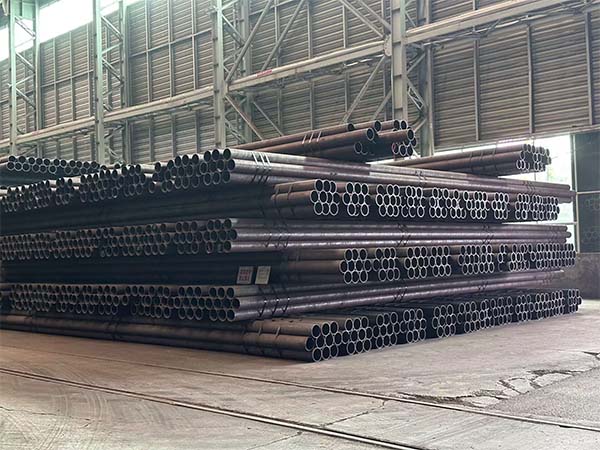Carbon steel pipe is a type of steel pipe mainly composed of carbon and iron, and also contains trace amounts of manganese, silicon, phosphorus, sulfur and other elements. According to the difference in carbon content, it can be classified into low-carbon, medium-carbon and high-carbon grades. With the increase of carbon content, its strength increases but its toughness and weldability decrease. Generally speaking, the carbon content of carbon steel pipes is approximately between 0.05% and 2.1%, and they can maintain good mechanical properties and economy under various pressure and temperature conditions.
What is carbon steel seamless pipe?
Carbon steel seamless pipes are hollow tubes formed by piercing solid steel billets and then using hot rolling or cold drawing processes in one step. As there are no welds or joints in the production process, its microstructure is more uniform, and its internal pressure resistance and fatigue performance are both superior to those of welded pipes. It is especially suitable for the transportation of high-temperature, high-pressure and corrosive media.

Specifications of carbon steel seamless pipes
Carbon steel seamless tubes are available in a variety of standards, sizes and lengths. Most carbon steel seamless tubes comply with specific ASTM, API and ASME standards. Carbon steel seamless pipes can be classified into the following major grades according to standards and applications:
ASTM A106
Seamless pipes suitable for high-temperature and high-pressure environments are widely used in oil refineries, power plants and boiler systems, and can withstand steam or hot fluids up to 500℃. Thanks to its excellent high-temperature resistance, ASTM A106 pipes play a crucial role in the mining industry.
ASTM A53
ASTM A53 is a type of structural and low-pressure pipe material widely used in fields such as construction, water supply and drainage, and gas pipelines. It includes two types: seamless (Type S) and welded (Type E/F), which can meet various engineering requirements.
API 5L
Designed specifically for oil and gas transportation, it is suitable for the oil and gas industry and covers multiple grades, including B, X42, X52, X60, X65, X70, etc. It meets the quality control requirements of PSL1/PSL2 standards and is particularly suitable for long-distance high-pressure transportation.
ASTM A333
Seamless steel pipes suitable for low-temperature services can adapt to environmental conditions of -50 ℃ and below, and have been widely used in liquefied natural gas facilities, low-temperature storage tanks, and petrochemical equipment in cold northern regions.
ASTM A179
Suitable for seamless cold-drawn low-carbon steel heat exchangers and condenser tubes. ASTM A179 tubes have precise dimensional control to ensure good sealing and heat transfer efficiency under high pressure and high temperature conditions.
ASTM A192
Seamless carbon steel boiler tubes suitable for high-pressure services. It features high strength and excellent thermal conductivity, making it an important material for manufacturing high-pressure boilers and superheaters. It is widely used in superheated steam pipes, flue pipes and water-cooled wall tubes of power station boilers, industrial boilers and waste heat boilers.
ASTM A252
They are usually used as seamless steel pipe piles and are specifically designed for structural support and infrastructure construction, such as support piles for Bridges, docks, buildings and highways. This kind of steel pipe pile is widely popular due to its outstanding strength, excellent corrosion resistance and weather resistance.
Note: If special requirements are needed, CENTRAL STTEL can provide more standard materials.
The size range of carbon steel seamless pipes
Diameter: 1/8 inch to 24 inches (3.175 mm to 609.6 mm).
Wall Thickness: 0.5 mm to 50 mm.
Length: SRL, DRL, 20FT, 40FT, 5 meters to 18 meters, or customized.
Production Process
Billet Preparation: High-quality carbon steel billets are heated to a high temperature.
Extrusion: The billet is extruded through a die to form a hollow shell.
Cold Drawing: The pipe is further processed through cold drawing to achieve precise dimensions and surface finish.
Heat Treatment: Normalizing or annealing is performed to enhance mechanical properties.
Inspection: The pipes undergo rigorous testing, including ultrasonic and hydrostatic tests, to ensure quality.
Typical application fields
Petroleum and natural gas: Long-distance pipelines, oil well casing, high-pressure steam pipelines;
Chemical engineering and oil refining: Transportation of corrosive media, reactor tube bundles, heat exchanger tubes;
Power generation and boilers: Superheaters, water supply pipes, gas turbines and boiler systems;
Low-temperature storage and transportation: liquefied natural gas storage tanks, low-temperature pipeline networks;
Machinery and Construction: Hydraulic cylinders, scaffolding, structural supports, automotive chassis.
